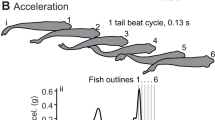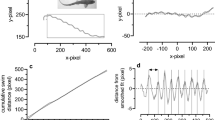Summary
Velocities of swimming and eye movements were measured in several species of nototheniid fish living at −1.9 °C in McMurdo Sound, Antarctica.
-
1.
The most common mode of swimming was labriform. The speed of labriform swimming inPagothenia borchgrevinki, a cryopelagic species, was a linear function of pectoral fin beat frequency, reaching a maximum of 38 cm s−1 (1.8 L s−1) at a fin beat frequency of about 2 Hz (Fig. 2).
-
2.
Subcarangiform swimming was employed for short dashes and escape responses. In this modeP. borchgrevinki attained a maximum swimming speed of 110 cm s−1 (4.9 L s−1) at a caudal fin beat frequency of 5.7 Hz.
-
3.
The maximum amplitude of saccadic eye movements was about 20° inP. borchgrevinki, and 30° in the benthic speciesTrematomus bernacchii andT. centronotus. In all 3 species, amplitude was correlated with saccade velocity (Fig. 6).
-
4.
Saccade velocities were variable compared with those of mammals. Outward saccades (away from the resting position of the eye) were slower than return saccades of the same amplitude. The maximum velocity of outward saccades was about 50 deg s−1; that of return saccades was about 120 deg s−1.
-
5.
Maximum swimming speeds in antarctic fish are close to speeds predicted by extrapolation to the same temperature from temperate fishes, but saccade velocities are higher than predicted. The difference is attributed to a relative lack of temperature compensation in muscle, while there is a greater degree of compensation in the central nervous system.
Similar content being viewed by others
Abbreviations
- A :
-
saccade amplitude
- L :
-
body length
- r :
-
correlation coefficient
- R :
-
saccade velocity
- S :
-
stride length
- s b :
-
standard error of regression coefficient
- T :
-
muscle twitch contraction time
- V :
-
maximum swimming speed
References
Andriashev AP (1970) Cryopelagic fishes of the arctic and antarctic and their significance in polar ecosystems. In: Holdgate MW (ed) Antarctic ecology, vol 1. Academic Press, London, pp 297–304
Baldwin J (1971) Adaptation of enzymes to temperature: acetylcholinesterases in the central nervous system of fishes. Comp Biochem Physiol 40B: 181–187
Bass EL (1971) Temperature acclimation in the nervous system of the brown bullhead (Ictalurus nebulosus). Comp Biochem Physiol 40A: 833–849
Brett JR, Sutherland DB (1965) Respiratory metabolism of pumpkinseed (Lepomis gibbosus) in relation to swimming speed. J Fish Res Bd Canada 22:405–409
Collins CC (1971) Orbital mechanics. In: Bach-y-Rita P, Collins CC, Hyde J (eds) The control of eye movements. Academic Press, New York, pp 283–325
Cossins AR (1977) Adaptation of biological membranes to temperature. The effect of temperature acclimation of goldfish upon the viscosity of synaptosomal membranes. Biochim Biophys Acta 470:395–411
Cossins AR, Prosser CL (1978) Evolutionary adaptation of membranes to temperature. Proc Natl Acad Sci USA 75:2040–2043
Cossins AR, Friedlander MJ, Prosser CL (1977) Correlations between behavioural temperature adaptations of goldfish and the viscosity and fatty acid composition of their synaptic membranes. J Comp Physiol 120:109–121
Cossins AR, Christiansen J, Prosser CL (1978) Adaptation of biological membranes to temperature. The lack of homeoviscous adaptation in the sarcoplasmic reticulum. Biochim Biophys Acta 511:442–454
DeWitt HH (1971) Coastal and deep-water benthic fishes of the Antarctic. In: Bushnell VC (ed) Antarctic map folio series, folio 15. Am Geogr Soc, New York, pp 1–10
Eastman JT, DeVries AL (1982) Buoyancy studies of notothenioid fishes in McMurdo Sound, Antarctica. Copeia 1982:385–393
Faber DS, Korn H (1978) Electrophysiology of the Mauthner cell: basic properties, synaptic mechanisms, and associated networks. In: Faber DS, Korn H (eds) Neurobiology of the Mauthner cell. Raven Press, New York, pp 47–131
Friedlander MJ, Kotchabhakdi N, Prosser CL (1976) Effects of cold and heat on behaviour and cerebellar function in goldfish. J Comp Physiol 112:19–45
Gestrin P, Sterling P (1977) Anatomy and physiology of goldfish oculomotor system. II. Firing patterns of neurons in abducens nucleus and their relation to eye movements. J Neurophysiol 40:573–588
Greene FC, Feeney RE (1970) Properties of muscle glyceraldehyde-3-phosphate dehydrogenase from the cold adapted antarctic fishDissostichus mawsoni. Biochim Biophys Acta 220:430–442
Helversen O von, Elsner N (1977) The stridulatory movements of acridid grasshoppers recorded with an opto-electronic device. J Comp Physiol 122:53–64
Hermann HT, Constantine MM (1971) Eye movements in the goldfish. Vision Res 11:313–331
Hochachka PW, Somero GN (1973) Strategies of biochemical adaptation. Saunders Co, Philadelphia
Holeton GF (1974) Metabolic cold adaptation of polar fish: fact or artefact? Physiol Zool 47:137–152
Huey RB, Stevenson RD (1979) Integrating thermal physiology of ecotherms: a discussion of approaches. Am Zool 19:357–366
Kehl TH, Morrison PR (1960) Peripheral nerve function and hibernation in the thirteen-lined ground squirrel,Spermophilus tridecemlineatus. Bull Mus Comp Zool Harvard 124:387–402
Kennett JP (1977) Cenozoic evolution of antarctic glaciation, the circum-antarctic ocean and their impact on global paleoceanography. J Geophys Res 82:3843–3876
Komatsu SK, Feeney RE (1970) A heat labile fructosediphosphate aldolase from cold-adapted antarctic fishes. Biochim Biophys Acta 206:305–315
Konishi J, Hickman CP (1964) Temperature acclimation in the central nervous system of rainbow troutSalmo gairdnerii. Comp Biochem Physiol 13:433–443
Lindsey CC (1978) Form, function, and locomotory habits in fish. In: Hoar WS, Randall DJ (eds) Fish physiology, vol 7. Academic Press, New York, pp 1–100
Littlepage JL (1965) Oceanographic investigations in McMurdo Sound, Antarctica. In: Llano GA (ed) Biology of the antarctic seas, vol 2. Am Geophys Union, Washington, DC, pp 1–37
Macdonald JA (1981) Temperature compensation in the peripheral nervous system: antarctic vs. temperate poikilotherms. J Comp Physiol 142:411–418
Macdonald JA, Montgomery JC (1982a) Miniature end plate currents from an antarctic fish. Proc Physiol Soc NZ 2:31
Macdonald JA, Montgomery JC (1982b) Thermal limits of neuromuscular function in an antarctic fish. J Comp Physiol 147:237–250
Montgomery J, McVean AR, McCarthy D (1983) The effects of lowered temperature on spontaneous eye movements in a teleost fish. Comp Biochem Physiol 75A:363–368
Paintal AS (1965) Effects of temperature on conduction in single vagal and saphenous myelinated nerve fibers of the cat. J Physiol (Lond) 180:20–49
Penney RK, Goldspink G (1979) Compensation limits of fish muscle myofibrillar ATPase enzyme to environmental temperature. J Therm Biol 4:269–272
Peterson RH, Prosser CL (1972) The effects of cooling on electrical responses of goldfish (Carassius auratus) central nervous system. Comp Biochem Physiol 42A:1019–1037
Prosser CL (1965) Electrical responses of fish optic tectum to visual stimulation: modification by cooling and conditioning. Z Vergl Physiol 50:102–118
Prosser CL, Farhi E (1965) Effects of temperature on conditioned reflexes and on nerve conduction in fish. Z Vergl Physiol 50:91–101
Renaud JM, Stevens ED (1981) The interactive effects of temperature and pH on the isometric contraction of toad sartorius muscle. J Comp Physiol 145:67–71
Robinson DA (1964) The mechanics of human saccadic eye movement. J Physiol (Lond) 174:245–264
Roots BI, Prosser CL (1962) Temperature acclimation and the nervous system in fish. J Exp Biol 39:617–629
Schoepfle GM, Erlanger J (1941) The action of temperature on the excitability, spike height and configuration, and the refractory period observed in the responses of single medullated nerve fibers. Am J Physiol 134:694–704
Somero GN, Giese AC, Wohlschlag DE (1968) Cold adaptation of the antarctic fish,Trematomus bernacchii. Comp Biochem Physiol 26:223–233
Talo A, Lagerspetz KYH (1967) Temperature acclimation of the functional parameters of the giant nerve fibres inLumbricus terrestris L. II. The refractory period. J Exp Biol 47:481–484
Walls GL (1962) The evolutionary history of eye movement. Vision Res 2:69–80
Wardle CS (1975) Limit of fish swimming speed. Nature 255:725–727
Wardle CS (1980) Effects of temperature on the maximum swimming speed of fishes. In: Ali MA (ed) Environmental physiology of fishes. Plenum Press, New York, pp 519–531
Wardle CS, Videler JJ (1980) How do fish break the speed limit? Nature 284:445–447
Webb PW (1973) Kinematics of pectoral fin propulsion inCymatogaster aggregata. J Exp Biol 59:697–710
Williamson RM, Roberts BL (1981) Body cooling as a supplement to anaesthesia for fishes. J Mar Biol Assoc UK 61:129–131
Wohlschlag DE (1964) Respiratory metabolism and ecological characteristics of some fishes in McMurdo Sound, Antarctica. In: Lee MO (ed) Biology of the antarctic seas, vol 1. Am Geophys Union, Washington, DC, pp 33–62
Author information
Authors and Affiliations
Rights and permissions
About this article
Cite this article
Montgomery, J.C., Macdonald, J.A. Performance of motor systems in Antarctic fishes. J. Comp. Physiol. 154, 241–248 (1984). https://doi.org/10.1007/BF00604989
Accepted:
Issue Date:
DOI: https://doi.org/10.1007/BF00604989




